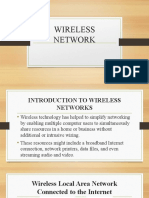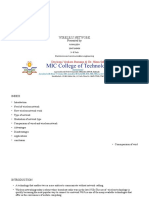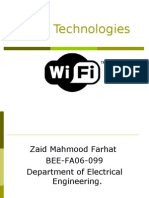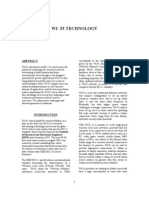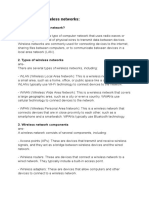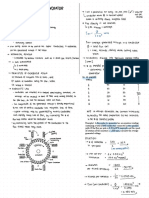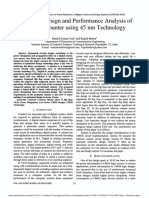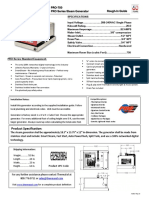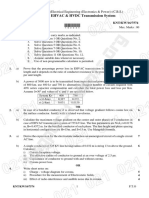WIMAX - WIRELESS INTRODUCTION
http://www.tutorialspoint.com/wimax/wireless_introduction.htm Copyright © tutorialspoint.com
Before we begin a real theory of WiMax, let's spend few minutes to understand background
concepts on which WiMax has evolved.
Wireless means transmitting signals using radio waves as the medium instead of wires. Wireless
technologies are used for tasks as simple as switching off the television or as complex as supplying
the sales force with information from an automated enterprise application while in the field. Now
cordless keyboards and mice, PDAs, pagers and digital and cellular phones have become part of
our daily life.
Some of the inherent characteristics of wireless communications systems which make it attractive
for users, are given below:
Mobility: A wireless communications system allows users to access information beyond
their desk and conduct business from anywhere without having a wire connectivity.
Reachability: Wireless communications systems enable people to be better connected and
reachable without any limitation of any location.
Simplicity: Wireless communication system are easy and fast to deploy in comparison of
cabled network. Initial setup cost could be a bit high but other advantages overcome that
high cost.
Maintainability: Being a wireless system, you do no need to spend too much to maintain a
wireless network setup.
Roaming Services: Using a wireless network system, you can provide service any where
any time including train, buses, aeroplanes etc.
New Services: Wireless communications systems provide new smart services like SMS and
MMS.
Wireless Network Topologies:
There are basically three ways to set up a wireless network.
Point-to-point bridge: As you know a bridge is used to connect two networks. A point-to-
point bridge interconnects two buildings having different networks. For example, a wireless
LAN bridge can interface with an Ethernet network directly to a particular access point.
Point-to-multipoint bridge: This topology is used to connect three or more LANs that may
be located on different floors in a building or across buildings.
Mesh or ad hoc network: This network is an independent local area network that is not
connected to a wired infrastructure and in which all stations are connected directly to one
another.
Wireless Technologies:
Wireless technologies can be classified in different ways depending on their range. Each wireless
technology is designed to serve a specific usage segment. The requirements for each usage
segment are based on a variety of variables, including Bandwidth needs, Distance needs and
Power.
Wireless Wide Area Network WWAN:
This network enables you to access the Internet via a wireless wide area network WWAN access
card and a PDA or laptop.
These networks provide a very fast data speed compared with the data rates of mobile
telecommunications technology, and their range is also extensive. Cellular and mobile networks
based on CDMA and GSM are good examples of WWAN.
�Wireless Personal Area Network WPAN:
These networks are very similar to WWAN except their range is very limited.
Wireless Local Area Network WLAN:
This network enables you to access the Internet in localized hotspots via a wireless local area
network WLAN access card and a PDA or laptop.
It is a type of local area network that uses high-frequency radio waves rather than wires to
communicate between nodes.
These networks provide a very fast data speed compared with the data rates of mobile
telecommunications technology, and their range is very limited. Wi-Fi is the most widespread and
popular example of WLAN technology.
Wireless Metropolitan Area Network WMAN:
This network enables you to access the Internet and multimedia streaming services via a wireless
region area network WRAN.
These networks provide a very fast data speed compared with the data rates of mobile
telecommunication technology as well as other wireless network, and their range is also extensive.
Issues with Wireless Networks:
There are following three major issues with Wireless Networks.
Quality of Service QoS: One of the primary concerns about wireless data delivery is that,
like the Internet over wired services, QoS is inadequate. Lost packets, and atmospheric
interference are recurring problems wireless protocols.
Security Risk: This has been another major issue with a data transfer over a wireless
network. Basic network security mechanisms like the service set identifier SSID and Wireless
Equivalency Privacy WEP. These measures may be adequate for residences and small
businesses but they are inadequate for entities that require stronger security.
Reachable Range: Normally wireless network offers a range of about 100 meters or less.
Range is a function of antenna design and power. Now a days the range of wireless is
extended to tens of miles so this should not be an issue any more.
Wireless Broadband Access WBA:
Broadband wireless is a technology that promises high-speed connection over the air. It uses radio
waves to transmit and receive data directly to and from the potential users whenever they want it.
Technologies such as 3G, Wi-Fi, WiMAX and UWB work together to meet unique customer needs.
BWA is a point-to-multipoint system which is made up of base station and subscriber equipment.
Instead of using the physical connection between the base station and the subscriber, the base
station uses an outdoor antenna to send and receive high-speed data and voice-to-subscriber
equipment.
BWA offers an effective, complementary solution to wireline broadband, which has become
globally recognized by a high percentage of the population.
What is Wi-Fi ?
Wi-Fi stands for Wireless Fidelity. Wi-Fi is based on the IEEE 802.11 family of standards and is
primarily a local area networking LAN technology designed to provide in-building broadband
coverage.
For more detail on Wi-Fi, please look into our Wi-Fi Tutorial.
Loading [MathJax]/jax/output/HTML-CSS/jax.js





